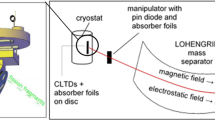Abstract
Calorimetric low temperature detectors (CLTD’s) for heavy-ion detection have been combined with the LOHENGRIN recoil separator at the ILL Grenoble for the determination of nuclear charge distributions of fission fragments produced by thermal neutron-induced fission of \(^{235}\)U. The LOHENGRIN spectrometer separates fission fragments according to their mass-to-ionic-charge ratio and their kinetic energy, but has no selectivity with respect to nuclear charges Z. For the separation of the nuclear charges, one can exploit the nuclear charge-dependent energy loss of the fragments passing through an energy degrader foil (absorber method). This separation requires detector systems with high energy resolution and negligible pulse height defect, as well as degrader foils which are optimized with respect to thickness, homogeneity, and energy loss straggling. In the present, contribution results of test measurements at the Maier Leibnitz tandem accelerator facility in Munich with \(^{109}\)Ag and \(^{127}\)I beams with the aim to determine the most suitable degrader material, as well as measurements at the Institut Laue–Langevin will be presented. These include a systematic study of the quality of Z-separation of fission fragments in the mass range \(82\le A \le 132\) and a systematic measurement of \(^{92}\)Rb fission yields, as well as investigations of fission yields toward the symmetry region.








Similar content being viewed by others
References
S. Kraft-Bermuth et al., Rev. Sci. Instrum. 80, 103304 (2009)
P. Egelhof, S. Kraft-Bermuth, Top. Appl. Phys. 99, 469 (2005)
A. Echler, P. Egelhof, P. Grabitz, H. Kettunen, S. Kraft-Bermuth, K. Müller, M. Rossi, W.H. Trzaska, A. Virtanan, J. Low Temp. Phys. 176, 1033 (2014)
E. Moll, H. Schrader, G. Siegert, H. Hammers, M. Asghar, J.P. Bocquet, P. Armbruster, H. Ewald, H. Wollnik, Kerntechnik 19, 374 (1977)
U. Quade, K. Rudolph, G. Siegert, Nucl. Instrum. Methods 164, 435 (1979)
A.A. Sonzogni, T.D. Johnson, E.A. McCutchan, Phys. Rev. C 91, 011301(R) (2015)
U. Quade, K. Rudolph, S. Skorka, P. Armbruster, H.G. Clerc, W. Lang, M. Mutterer, C. Schmitt, J.P. Theobald, F. Gönnenwein, J. Pannicke, H. Schrader, G. Siegert, D. Engelhardt, Nucl. Phys. A 487, 1 (1988)
H.G. Clerc, K.H. Schmidt, H. Wohlfahrth, W. Lang, H. Schrader, K.E. Pferdekämper, R. Jungmann, M. Ashgar, J.P. Bocquet, G. Siegert, Nucl. Phys. A 274, 74 (1974)
G. Siegert, H. Wollnik, J. Greif, G. Fiedler, M. Ashgar, G. Bailleul, J.P. Bocquet, J.P. Gautheron, H. Schrader, H. Ewald, P. Armbruster, Phys. Lett. B 53, 45 (1974)
Acknowledgments
We would like to thank Norbert Laurens (ILL, Grenoble) for the technical support during the preparation time and the measurement performed at the LOHENGRIN mass separator. We also thank the operator group of the Maier Leibnitz tandem accelerator facility in Munich for the technical support during the test measurement. This work was supported by the German Research Council (DFG) by means of the Emmy Noether Program.
Author information
Authors and Affiliations
Corresponding author
Rights and permissions
About this article
Cite this article
Grabitz, P., Andrianov, V., Bishop, S. et al. Determination of Nuclear Charge Distributions of Fission Fragments from \(^{235}\)U (\(n_\mathrm{th}\), f) with Calorimetric Low Temperature Detectors. J Low Temp Phys 184, 944–951 (2016). https://doi.org/10.1007/s10909-016-1566-0
Received:
Accepted:
Published:
Issue Date:
DOI: https://doi.org/10.1007/s10909-016-1566-0




